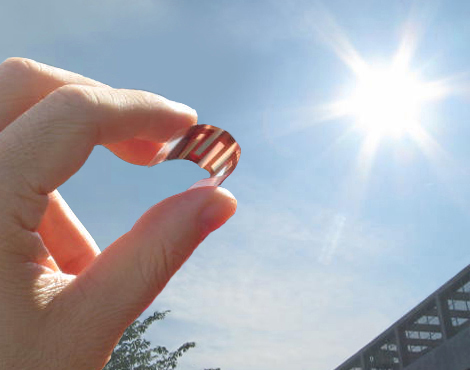Organic Photovoltaic Cells of the Future

Yutaka Moritomo/University of Tsukuba Researchers develop method to screen organic materials for organic photovoltaic cells by charge formation efficiency.
Organic photovoltaic cells — a type of solar cell that uses polymeric materials to capture sunlight — show tremendous promise as energy conversion devices, thanks to key attributes such as flexibility and low-cost production.
But one giant hurdle holding back organic photovoltaic technologies have been the complexity of their power conversion processes, which involve separate charge formation and transport processes.
To maneuver around this problem, a team of researchers in Japan has developed a method to determine the absolute value of the charge formation efficiency. The secret of their method, as they report in Applied Physics Letters, is the combination of two types of spectroscopy.
The two types the team uses are photo-induced spectroscopy to determine the change in absorption after femtosecond photo-pulse excitation, and electrochemical spectroscopy to examine the absorption change due to charge injection.
“By qualitative analysis of the spectral change, we can deduce how many charges are produced by one photon — its charge formation efficiency,” said Professor Yutaka Moritomo, Institute of Materials Science at the University of Tsukuba.
Just how significant is this? It's a huge step forward, said Moritomo, and the team also discovered that the charge formation efficiency remains high (0.55) even at low temperatures (80 K).
“This was extremely surprising,” Moritomo said, since the positive and negative charges are strongly bound in an organic photovoltaic device as an exciton — a bound state of an electron and hole, which are attracted to each other by the electrostatic Coulomb force.
“Its charge formation was believed to be too difficult without a thermal activation process,” explained Moritomo. “But our work shows that the charge formation process of an organic photovoltaic device is purely quantum mechanical, and any theoretical model should explain the high charge formation efficiency at low temperatures.”
The team's work will enable the high-throughput screening of organic materials for new organic photovoltaic devices. “Organic materials have several requirements — including high charge formation efficiency and high charge transport efficiency — so our method can be used to quickly screen the materials by charge formation efficiency,” Moritomo said.
Next for the team? “Now that we have a method to determine the key physical parameter, charge formation efficiency, we're exploring the interrelation between it and the nanoscale structure of the organic photovoltaic device to clarify the mechanism of the charge formation,” noted Moritomo.
The article, “Effect of temperature on carrier formation efficiency in organic photovoltaic cells,” is authored by Yutaka Moritomo, Kouhei Yonezawa and Takeshi Yasuda. It will appear in the journal Applied Physics Letters on August 19, 2014. After that date, it can be accessed at: http://scitation.aip.org/content/aip/journal/apl/105/7/10.1063/1.4892611
ABOUT THE JOURNAL
Applied Physics Letters features concise, rapid reports on significant new findings in applied physics. The journal covers new experimental and theoretical research on applications of physics phenomena related to all branches of science, engineering, and modern technology. See: http://apl.aip.org
Media Contact
All latest news from the category: Materials Sciences
Materials management deals with the research, development, manufacturing and processing of raw and industrial materials. Key aspects here are biological and medical issues, which play an increasingly important role in this field.
innovations-report offers in-depth articles related to the development and application of materials and the structure and properties of new materials.
Newest articles

Recovering phosphorus from sewage sludge ash
Chemical and heat treatment of sewage sludge can recover phosphorus in a process that could help address the problem of diminishing supplies of phosphorus ores. Valuable supplies of phosphorus could…

Efficient, sustainable and cost-effective hybrid energy storage system for modern power grids
EU project HyFlow: Over three years of research, the consortium of the EU project HyFlow has successfully developed a highly efficient, sustainable, and cost-effective hybrid energy storage system (HESS) that…

After 25 years, researchers uncover genetic cause of rare neurological disease
Some families call it a trial of faith. Others just call it a curse. The progressive neurological disease known as spinocerebellar ataxia 4 (SCA4) is a rare condition, but its…





















